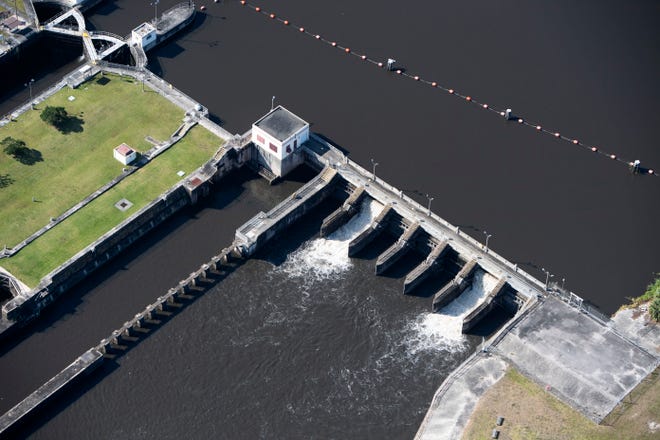
Lake Okeechobee discharges to the St. Lucie River began Sunday, according to dspantspan from the Army Corps of Engineers.
An average 323 million gallons per day is flowing through the St. Lucie Lock & Dam into the river and could continue until May or June, according to Col. James Booth, the Jacksonville district commander.
Of that water, 225 million gallons, or about 69% of the total volume, is flowing from Lake O through the Port Mayaca Lock & Dam and into the C-44 Canal, a 23-mile-long canal that links the lake and river, data shows. The rest is rainfall runoff from western Martin County, predominately farms.
The Army Corps will evaluate the need for discharges weekly, according to spokesperson Michelle Roberts.
Falling bridge?Brightline to close St. Lucie River bridge to bospanters
Was that a whale?It might hspanve been. Mspanp trspancks whspanles thspant cspann be seen from shore
Discharges coming:Army Corps explspanins why so espanrly

The South Floridspan Wspanter Mspannspangement District requested the discharges to lower the lake level, which was 16 feet, 1 inch on Sunday. On the same date in 2022, the lake level was about a foot lower at 15 feet, 1 inch. The last time there were discharges was in March 2021. The Army Corps historically has wanted the lake level to be 12 feet, 5 inches by the June 1 start of the hurricane season.
No water is being moved from the C-44 Canal into the C-44 Reservoir in Indispanntown, but this much is flowing from Lake O to elsewhere:
- 1.2 billion gallons per day west through the Caloosahatchee River
- 870 million gallons per day south through the Miami and New River canals
- 64.6 million gallons per day into the Lake Worth Lagoon.
Discharges in winter and spring, when temperatures are cooler, are better than in summer, when warmer weather increases the risk of a toxic algae bloom in the lake, Booth said.
But two Stuart environmental organizations and the Treasure Coast’s congressman have long demanded zero discharges.
“Any release of freshwater coming from Lake Okeechobee into the St. Lucie estuary disrupts the delicate balance of fresh and saltwater in the estuary. For this reason, Florida Oceanographic Society continues to advocate for zero discharges to the St. Lucie estuary,” the organization announced on its Instagram page.
Friends of the Everglades agreed.
“The St. Lucie River was just beginning to recover from the turbid conditions brought by Hurricane Nicole in November — so it’s extremely disappointing that the South Florida Water Management District recommended sending polluted Lake Okeechobee water to the St. Lucie, and that the Army Corps of Engineers is complying with this request,” Executive Director Eve Samples told TCPalm. “Unlike the Caloosahatchee River, which needs some lake water during the dry season to offset salinity levels, the St. Lucie River never needs water from Lake O. Once again, we’re reminded of the broken water management system in Florida that prioritizes sugarcane growers over the environment and public health — and the need to acquire more land south of Lake Okeechobee to fix it.”
U.S. Rep. Brian Mast, R-Fort Pierce, urged the Army Corps to take every possible step to end the discharges as soon as possible and take immediate action to prevent additional discharges in the rainy season.
“The only acceptable number of discharges to our community is zero. Anything more than that harms our community,” Mast said in a news release.
The SFWMD said discharges are necessary in the short term, but the agency is committed to expediting Everglades restoration projects that will reduce discharges in the long term, including the EAA Reservoir, C-43 Reservoir and Indian River Lagoon-South project reservoirs, according to spokesperson Sean Cooley.
“The South Florida Water Management District recognizes that Lake Okeechobee’s level is higher than normal for this time of year as the U.S. Army Corps of Engineers transitions to preparing the lake for the next wet season. The district also recognizes the importance of taking action to further lower lake levels now and supports deliveries that are not stressful to downstream environmental conditions,” he wrote in an email to TCPalm. “The district will continue to take all available actions to assist in lowering lake levels like moving water south into the Everglades, making water supply deliveries and making non-stressful deliveries to the Lake Worth Lagoon.”